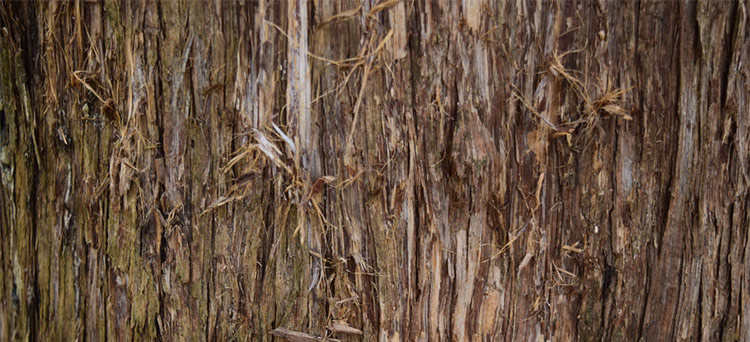Virginian Cedarwood Essential Oil
Juniperus virginiana

Description
Virginian Cedarwood Essential Oil is one of the first three essential oils that I purchased many years ago. At that time, I knew next to nothing about its therapeutic benefits. Instead, I had fallen in love with the rich, sweet, calming, woody aroma that reminded me of the scent of cedar closets.

Since then, I have used it not only for its calming properties, but I find it to be comforting and beneficial when incorporated into blends that I use when a cold has me coughing. It can be helpful for all skin types, particularly oily or acne prone skin. It is helpful to use in insect repellent blends, and I sometimes include it in blends that I use for meditation and spiritual work to "soften" the heavier aromas (i.e. spikenard or vetiver) that I blend with for meditation.
Because Atlas Cedarwood is endangered, Virginian Cedarwood Essential Oil is a much more sensible choice for use from a sustainability perspective. See the Sustainability and Conservation Status section below for more information.
Atlas Cedarwood Essential Oil and Virginian Cedarwood Essential Oil differ in aroma. Although I also love the aroma of Atlas Cedarwood essential Oil and consider both Virginian and Atlas oils to be oils of "strength," there are times that I prefer the softer aroma of Virginian Cedarwood Essential Oil.
Virginian Cedarwood is a conifer. You can learn more about conifers by reading AromaWeb's Guide to Coniferous Essential Oils.
Virginian Cedarwood Essential Oil Benefits and Uses
- Anxiety
- Nervous Tension
- Concentration
- Catarrhal Conditions
- Coughs
- Chronic Bronchitis
- Cystitis
- UTI
- Oily Skin
- Acne
- Insect Repellent
- Acne
- Arthritis
- Bronchitis
- Coughs
- Cystitis
- Dandruff
- Dermatitis
- Insect Repellent
- Stress
Sources: Salvatore Battaglia, The Complete Guide to Aromatherapy (Australia: The Perfect Potion, 2003), 178-179. Julia Lawless, The Encyclopedia of Essential Oils (Updated Edition) (London: Harper Thorsons, 2014), 208-214
Botanical Name
Plant Family
Common Method of Extraction
Steam Distilled
Plant Part Typically Used
Color
Clear
Consistency
Medium and oily feeling
Perfumery Note
Base
Strength of Initial Aroma
Medium
Aromatic Description
Virginian Cedarwood Essential Oil smells deep, woody and balsamic. It strongly resembles the aroma of cedar chests and closets.
Sustainability and Conservation Status
Least Concern
Source: https://www.iucnredlist.org/species/42257/2967510
Virginian Cedarwood is classified as being amongst the least concerning (least risk of being threatened). Atlas Cedarwood, on the other hand, is endangered. From a conservation perspective, it is better to use Virginian Cedarwood Essential Oil than it is to use Atlas Cedarwood Essential Oil.
To learn more about the conservation status of essential oil bearing plants and how to use the IUCN Red List of Threatened Species, please refer to AromaWeb's Guide to Essential Oils and Sustainability.
Sustainability and Conservation Status
Least Concern
Source: https://www.iucnredlist.org/species/42257/2967510
To learn more about the conservation status of essential oil bearing plants and how to use the IUCN Red List of Threatened Species, please refer to AromaWeb's Guide to Essential Oils and Sustainability.
Major Constituents
- a-Cedrene
- Thujopsene
- Cedrol
- B-Cedrene
- a-Selinene
See Essential Oil Safety for more complete list of typical constituents.
Source: B.M. Lawrence, Progress in Essential Oils. (Perfumer & Flavorist 23 no. 5, 1998), 67-68. Source cited in Robert Tisserand and Rodney Young, Essential Oil Safety (Second Edition. United Kingdom: Churchill Livingstone Elsevier, 2014), 240.
Virginian Cedarwood Essential Oil Safety Information
Tisserand and Young do not indicate any special precautions when using Virginian Cedarwood Oil. Reading Tisserand and Young's full profile is recommended. [Robert Tisserand and Rodney Young, Essential Oil Safety (Second Edition. United Kingdom: Churchill Livingstone Elsevier, 2014), 240.]
General Safety Information
Do not take any oils internally and do not apply undiluted essential oils, absolutes, CO2s or other concentrated essences onto the skin without advanced essential oil knowledge or consultation from a qualified aromatherapy practitioner. For general dilution information, read AromaWeb's Guide to Diluting Essential Oils. If you are pregnant, epileptic, have liver damage, have cancer, or have any other medical problem, use oils only under the proper guidance of a qualified aromatherapy practitioner. Use extreme caution when using oils with children and be sure to first read the recommended dilution ratios for children. Consult a qualified aromatherapy practitioner before using oils with children, the elderly, if you have medical issues or are taking medications. Before using this or any essential oil, carefully read AromaWeb's Essential Oil Safety Information page. For in-depth information on oil safety issues, read Essential Oil Safety by Robert Tisserand and Rodney Young.
Shelf Life
Important Information About the Profiles
The essential oil information provided on AromaWeb is intended for basic educational purposes only. The references to safety information, test results, constituents and percentages is generalized information. Essential oils can vary greatly in composition. The data is not necessary complete and is not guaranteed to be accurate. The essential oil photos are intended to represent the typical and approximate color of each essential oil. However, essential oil composition and color can vary based on harvesting, distillation, age of the essential oil and other factors. Profiles for several CO2 Extracts and absolutes are included within the directory, and are denoted as such.
